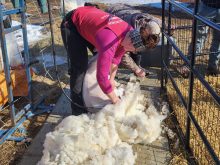RED DEER Ñ A beetle the size of a grain of rice is devastating British Columbia’s pine forests.
The mountain pine beetle is found mostly in the province’s interior forests. It is expected to kill up to 80 percent of lodgepole pines by 2013, leaving acres of standing dead trees the colour of red brick.
The Council of Forest Industries representing the B.C. interior logging industry estimated the insects have affected 283.5 million cubic metres of timber, spread over an area larger than Sweden.
The province has committed more than $200 million over the last five years to control the mountain pine beetle and is looking for ways to salvage the dead trees, said Brad Stennes of the Canadian Forest Service.
Read Also

Charges laid after cattle theft
Saskatchewan RCMP lay two charges against a man after six cattle went missing.
“Right now there are about 280 million cubic metres of standing dead pine. That is four times B.C.’s annual harvest,” he said at the annual meeting of the Alberta agricultural economists in Red Deer May 6.
The trees present a serious fire hazard or could cause stagnation in the forests because nothing can grow around the decaying, dead wood. Loss of the timber also means loss of wildlife habitat and economic hardship to the region.
Possible solutions are to remove the dead trees for lumber or turn them into chips and burn them to generate electricity.
B.C. has mandated 50 percent of new energy production must come from green sources. The province already produces 650 megawatts of power from burning wood. Most of it is used to fire pulp and paper mills on the coast.
The amount of dead timber available could be used for green energy but it is expensive to harvest, to transport out of the area and process for burning. Further, the supply of wood is not necessarily sustainable 10-15 years from now.
“Those elevated harvest levels in about a decade are going to crash,” he said.
“In 2015, you are going to go from a period of a lot of excess fibre to everybody scrapping for lumber,” he said.
Since the beetle problem is spreading into the Yukon and Alberta, Stennes suggested joint efforts are needed to solve the problem.
This year the province increased the allowable annual cut in the Prince George, Quesnel and Lakes timber supply areas. These are the areas hardest hit by the insect in the province.

















